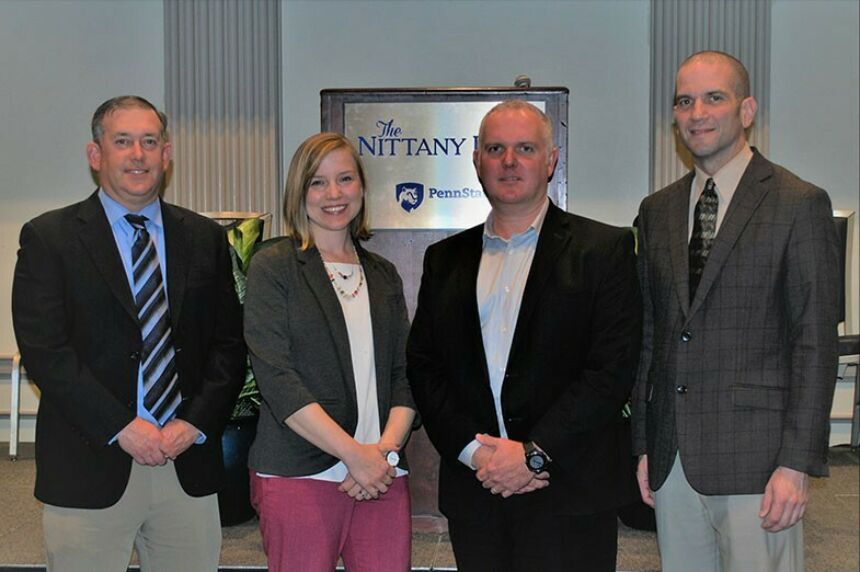November 27, 2019
Engineering design firm gifts $50K to architecture and architectural engineering

By Mariah Chuprinski, Communications Strategist, College of Engineering
UNIVERSITY PARK, Pa. – Citing a desire for a collaborative curriculum across departments, Philadelphia-based engineering design firm EwingCole recently committed $25,000 to each of the Departments of Architecture and Architectural Engineering (AE) at Penn State.
Known as the EwingCole Endowment for Systems Integration, the $50,000 fund will establish special events and activities, bridging together the architecture and AE curricula in the study of building systems integration.
“At EwingCole, we design and approach buildings holistically: we don’t focus on just the engineering or architecture aspect in any project we do,” said Jared Loos, CEO of EwingCole and a 1994 architectural engineering alumnus of the structural option. “We hire Penn State graduates of both the architecture and architectural engineering programs and really foster the integration of both backgrounds at the firm. For that reason, we wanted to create a fund that would foster collaboration in the classroom in parallel to how our firm operates.”
Loos explained that there are many areas in which architects and architectural engineers collaborate on projects at EwingCole.
“Sometimes when there is a difficult problem in a building project, the answer doesn’t lie solely in architecture or solely in architectural engineering,” Loos said. “The solution is found in an integration of both fields. We approach everything that way, including the orientation of buildings, the lighting in a space, ventilation challenges and so much more.”
The gift will fund extracurricular activities like student travel to firms and project sites, as well as in-class lectures on the topics of systems integration.
“This new fund will allow our students to learn how to design fully-integrated building systems in an interactive, interdisciplinary environment,” said Sez Atamturktur, Harry and Arlene Schell Professor and head of the Department of Architectural Engineering. “We are grateful for EwingCole’s support of our program and are excited to partner with them to produce exciting educational events and initiatives in the near future.”
The first of those events took place on Nov. 11 at the Nittany Lion Inn where Loos and three other EwingCole representatives presented on a recently completed building project, the United Therapeutics headquarters in Silver Spring, Maryland, which is a zero net energy building.
“In our talk, we refuted the misconception that high-performance buildings can only be achieved by sacrificing design,” said Jennifer Wampler, principal and project manager with EwingCole, who presented with Loos and two other colleagues. “Other talks that are funded by this gift will similarly illustrate the integration of architecture and engineering results in sophisticated design and building performance.”
EwingCole has a history of philanthropy at Penn State. The company created an endowment of $20,000 in 1992 that is used for a $500 scholarship awarded annually to two students – one fourth-year architecture student and one fourth-year AE student – who have achieved outstanding academic success in their studies.
In 2016, EwingCole increased its endowment and now awards $1,000 annually to two students.
Mehrdad Hadighi, professor and head of the Department of Architecture, looks forward to the innovative additions to the architecture curriculum the gift will fund.
“The EwingCole funds will help us reinforce the existing academic mechanisms that guide students in comprehensive thinking about architecture,” he said. “Through lectures, construction site visits and other student engagements, we intend to expand the conceptual strength of technical systems in architecture.”
This gift will advance "A Greater Penn State for 21st Century Excellence," a focused campaign that seeks to elevate Penn State’s position as a leading public university in a world defined by rapid change and global connections. With the support of alumni and friends, “A Greater Penn State” seeks to fulfill the three key imperatives of a 21st-century public university: keeping the doors to higher education open to hardworking students regardless of financial well-being; creating transformative experiences that go beyond the classroom; and impacting the world by fueling discovery, innovation and entrepreneurship. To learn more about “A Greater Penn State for 21st Century Excellence,” visit greaterpennstate.psu.edu.
